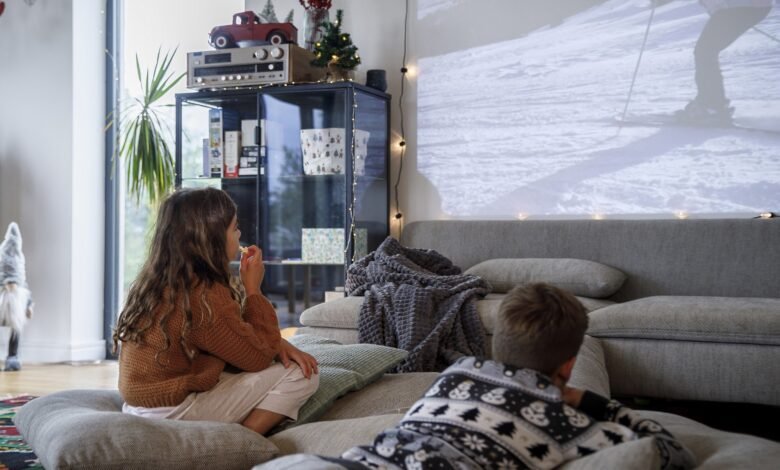Is It Worth It: Getting a Projector Instead of a TV

For as much time as we spend watching TV (hint: a lot), we spend almost as much time (well, maybe not quite) trying to minimize the appearance of our televisions in our living spaces. One possible solution that has gained popularity in recent years? Getting rid of your traditional TV and opting for a projector instead. Here, we explore the pros and cons of making the switch.
Pro: Projectors can be (nearly) invisible when not in use.
By far, the biggest design perk of a projector is the flexibility it offers in terms of where it goes and its ability to disappear when you’re not using it. Modern projectors are compact, quiet, and have a short throw—meaning you can set them up just inches from your wall and enjoy an impressive 4K picture projected up to 130 inches in size. Place them on a bookshelf opposite your screen or on a coffee table, as Adrienne Breaux, homes director at Apartment Therapy does. “When we have guests over and don’t want the projector in view, we just slip it into a box under the sofa,” she adds.

(Getty Images)
Con: You’ll need a surface for the projector to project onto.
A screen is the most logical choice and, to make the most of your viewing experience, Lydia Cho, head of TV product marketing at Samsung Electronics America, recommends using an ambient light rejection (or ALR) screen. “They help minimize ambient light, so you get an even better picture, improved color, and brightness,” she explains. An ALR screen doesn’t come cheap—expect to spend anywhere from a few hundred dollars to thousands depending on size and quality—and Cho adds that when you invest in a quality projector, you don’t necessarily need a dedicated screen. “A wall or other flat surface can work,” she says.
For her screen, Breaux offers a creative solution: “We made a large wooden frame and added stretched canvas from our local fabric store to both sides. One side is left white, while the other is painted with an abstract design. During the day, it rests on our fireplace mantel as a beautiful piece of art. At night, we turn it on its side, rest it on an ottoman in front of the fireplace, and voilà—a huge ‘TV’ for movie nights and binge-watching.”
Pro: You can DIY the install.
Unless you have a dedicated media room with a ceiling-mounted projector and high-end sound system, there’s no need for professional help. “It can be as simple as plugging it in, connecting to your network, and finding a surface,” says Cho. And if you’re crafty, check out this incredible DIY by Drew Michael Scott, involving a vintage hutch with a built-in projector screen.
Con: Picture quality can be an issue in the daytime.
“If you watch a lot during daylight hours, a projector might not be the best choice unless you can really darken the room,” says Breaux. “It doesn’t need to be pitch black, but the brighter your room is, the more you’ll lose in picture quality. This is especially true for moody shows, where you risk losing details otherwise.” This isn’t as much of an issue with high-end models paired with an ALR screen, but with low- and mid-range projectors you won’t get the same crisp, saturated, and detailed picture quality you would on a television. That lack of brightness, however, may appeal to some. “I love that a projector isn’t as intense as a TV because it’s easier on my eyes at night,” says Danielle Armstrong, an interior and prop stylist in Los Angeles.
Pro: Projectors can be portable.
A TV is rarely described as portable, but a projector can be. “One of my favorite things about my projector is that I can take it to a friend’s house for parties or movie nights,” says Armstrong. While moving your setup around your home daily isn’t ideal, it’s an option when needed—say, if you want to take it to a vacation home or rental.

(Getty Images)
Con: You’ll need an external speaker system for high-quality sound.
As with most projector features, sound quality depends on the model, but Armstrong brought it up as a “con” based on her experiences. “Honestly, the speakers on most I’ve tried are not so great, and you have to have an external speaker which may or may not be a deal breaker for some,” she explains. This is, of course, true of some televisions, as well, where sound bars are a common add-on.
Pro: Projectors have uses other than television viewing.
“This is perhaps only helpful for 1% of people out there, but a projector is great for murals and other art and craft projects,” says Breaux. “I throw a huge Halloween party every year where I make all my own decor, and my projector is key to helping me trace scenes and motifs onto wood that I cut out later. Not everyone might need this service, but it sure comes in handy for me!”
Con: Projectors can be as expensive, or even pricier, than a TV.
Budget-friendly projectors range from $100 to $300 and are OK for casual or occasional viewing (think: summer movies on the lawn), while mid-range models—which have better picture quality and streaming capabilities—will run you up to $1,000. High-end projectors can start at $3,000 and go upward of $7,000 or more.
The bottom line:
If your ultimate goal when viewing shows, movies, and gaming is picture quality, a traditional television is still probably your best bet. Projectors, though, have come a long way and shouldn’t be overlooked if a television set isn’t the right choice for your home or lifestyle. If you regularly do a lot of watching during the day, you’ll want to be sure to invest in at least a mid-range projector and an ALR screen to ensure your image quality is up to snuff. As a general rule, Cho recommends focusing on color and brightness: “Look for models with well-balanced brightness and contrast, true UHD Alliance-certified 4K resolution, and better color accuracy to maximize every detail on screen.”
Ready to shop? Here are our top picks, regardless of budget:
If you want something cheap but well-rated: HAPPRUN Google TV Projector with WiFi and Bluetooth, $200 at Walmart
If you want quality that’s also portable: Samsung The Freestyle 2nd Gen Smart Portable Projector, $598 at Best Buy
If you’re a gamer: BenQ X3100i True 4K Gaming Projector UHD 4LED, $2,199 at Amazon
If you need a solid option for your small living room: BenQ HT2150ST Short Throw 1080p Full HD Gaming Video Projector, $1,099 at Walmart
If you’re setting up a home theater but don’t want to spend a fortune: BenQ TK860i Smart Home Theater Projector 4K HDR Streaming with LED Vibrant Color, $1,000 at Amazon
If you want all the bells and whistles (and great daytime viewing): 130″ Class The Premiere 9 4K Smart Triple Laser Projector, $6,000 at Samsung




